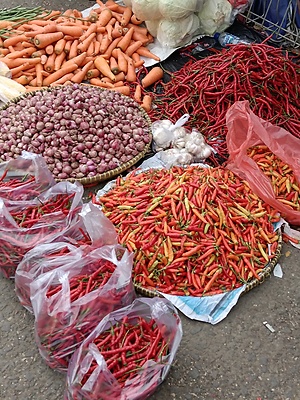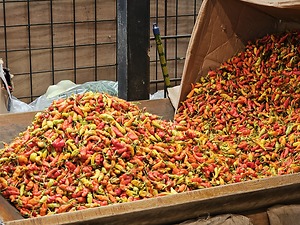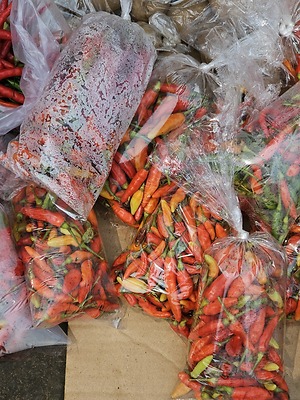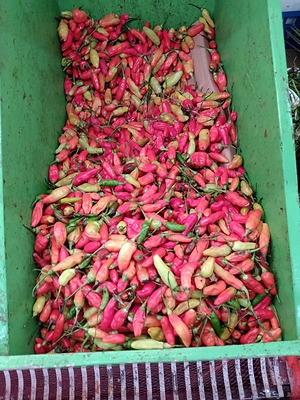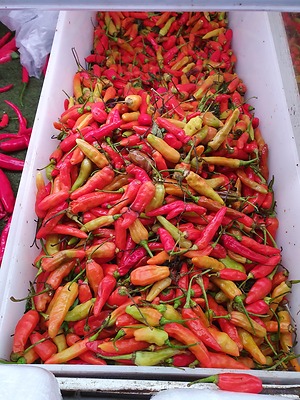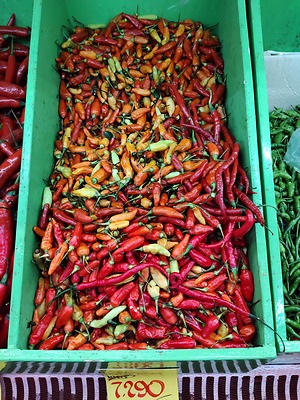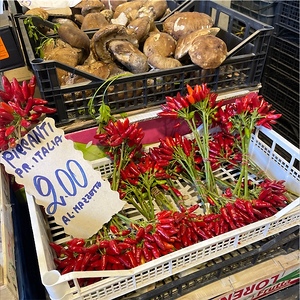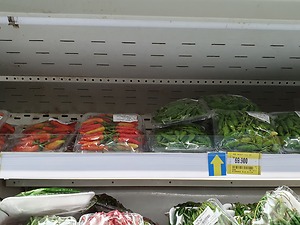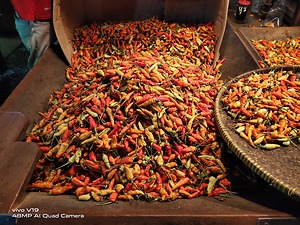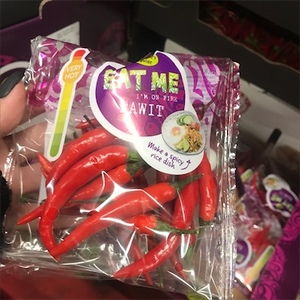

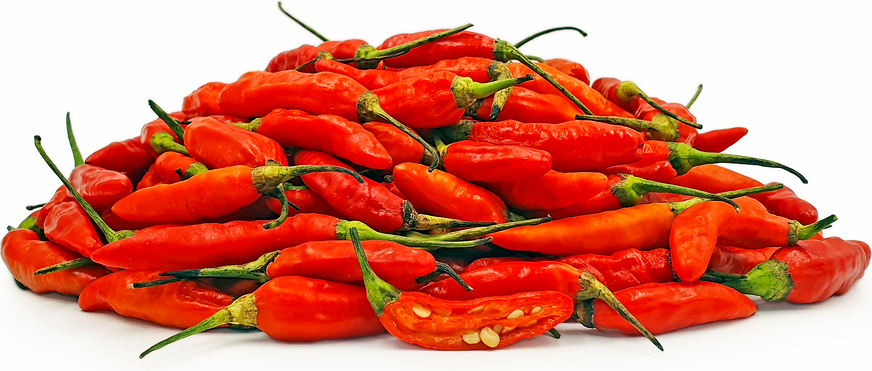
Cabe Rawit Merah Peppers
Estimated Inventory, lb : 0
Description/Taste
Cabe Rawit Merah are small, slender pods, averaging 2 to 4 centimeters in length, and have a slightly tapered, conical shape with rounded ends. The skin is semi-glossy, waxy, and smooth, ripening from green, yellow, orange, to bright red when mature. The flesh is crisp, aqueous, and is also found in varying shades, encasing a central cavity with round, cream-colored seeds. Cabe Rawit Merah are crunchy with a fruity, spicy flavor and are known to carry a lingering, fiery heat.
Seasons/Availability
Cabe Rawit Merah are available year-round.
Current Facts
Cabe Rawit Merah, botanically classified as Capsicum frutescens, are small peppers that grow on leafy plants reaching up to one meter in height and are members of the Solanaceae or nightshade family. Translating from Indonesian to mean “little chile” or “red cayenne pepper,” Cabe Rawit Merah are one of the most cultivated pepper varieties in Indonesia and are commonly found in local markets both fresh and dried. The name Cabe Rawit Merah is also sometimes used as a general descriptor for many varieties of red chile peppers in Indonesia. Cabe Rawit Merah pack a fiery heat, ranging 50,000 to 100,000 SHU on the Scoville scale, and have even inspired an Indonesian proverb that states to not judge something by its small size. In Indonesia, Cabe Rawit Merah are often found fresh and are utilized as a flavoring in sambals, soups, and stir-fries.
Nutritional Value
Cabe Rawit Merah get their spicy nature from capsaicin, which is a chemical compound found in peppers that causes the brain to feel the sensation of spice or heat. The peppers have also been studied for their ability to improve blood circulation, detoxify the body, and contain vitamins C, A, E, and K, potassium, and manganese.
Applications
Cabe Rawit Merah can be consumed fresh, out-of-hand, or utilized in cooked applications such as frying, roasting, sautéing, boiling, and steaming. When fresh, the peppers are often paired with fried fish or fritters and are served in small paper bags with the food to be consumed in between bites for a spicy kick. Cabe Rawit Merah can also be ground into sauces, marinades, and pastes, or they can be sliced and added to salads, soups, curries, and stir-fries. In addition to cooked applications, the peppers can be pickled with vinegar, salt, sugar, and vegetables such as cucumbers and carrots and are served in jars as a condiment. In Indonesia, Cabe Rawit Merah are popularly served with satay, which are grilled meats, mixed into nasi goreng or fried rice, and compliment flavors of seafood and fried tofu. It is also common to find a bowl of the fresh peppers on restaurant tables so the peppers can be added at any point into the meal to deepen the flavor of the dishes. Cabe Rawit Merah pairs well with lime, lemongrass, basil, vinegar, shallots, garlic, ginger, tomatoes, seafood, pineapple, mango, durian, and peanuts. Fresh peppers will keep 2-3 weeks when stored whole and unwashed in the refrigerator, and when dried, the peppers can be ground and used as a spice for up to one year.
Ethnic/Cultural Info
In Indonesia, sambal is a paste-like condiment served with almost every meal. Generally spicy, sambal utilizes Cabe Rawit Merah by grinding the peppers with other spices, vegetables, and oils to make a fiery paste to layer on eggs, rice, and cooked meats, or to mix into soups, curries, and salads. Sambal is one of the few condiments that can be seen in Indonesia at both street markets and high-end dining, and there are hundreds of variations of sambal, each with varying flavors and levels of heat. One of the most popular versions of sambal includes shrimp paste for a salty, spicy blend. Traditional Indonesian cooking centers around balanced flavors of sour, salty, sweet, spicy, and savory, and sambal is an element that locals believe adds depth to bland dishes. Outside of Indonesia, sambal has also become popular in other Southeast Asian cuisines such as Thai and Malaysian.
Geography/History
Peppers are native to Central and South America and have been growing wild since ancient times. When Spanish and Portuguese explorers arrived in the New World, they brought seeds of many pepper varieties back with them to Europe where European sailors and Arab merchants further carried them over to Asia. It is believed that peppers were introduced to Southeast Asia in the 16th century, and while the exact details of how quickly the plants spread is unknown, the spicy fruits became widely cultivated in Asia with new varieties being cultivated and developed. Cabe Rawit Merah can be found in both fresh and dried form at local markets in Thailand, Vietnam, Indonesia, Malaysia, Sri Lanka, and Laos.
Recipe Ideas
Recipes that include Cabe Rawit Merah Peppers. One
| Indoindians |
|
Sambal Lado |
| 196 Flavors |
|
Sambal |



